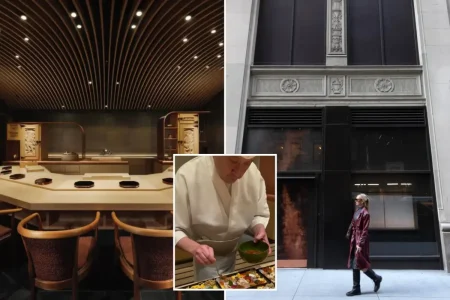The Rise and Fall of Olive Loaf: America’s Forgotten Lunchbox Staple
Once a common sight in American lunchboxes, olive loaf—that curious pink processed meat studded with bright green olives and red pimentos—has largely vanished from our collective culinary consciousness. This peculiar deli meat had its golden age from the 1940s through the 1970s, offering what Professor Marla Royne Stafford of the University of Nevada calls a “visually more interesting” alternative to plain bologna. For a generation of Americans, olive loaf represented a small touch of sophistication in an otherwise ordinary sandwich. Its distinctive appearance—those vibrant green and red jewels embedded in pale pink meat—made it stand out in an era when practical, affordable food was essential. While it secured a place in pop culture through films like “The Breakfast Club,” where Ally Sheedy’s character ultimately rejected it for a more eccentric sandwich creation, olive loaf’s journey from lunchbox staple to nostalgic curiosity reflects changing American tastes, health consciousness, and food culture over the decades.
The post-World War II era created the perfect conditions for olive loaf to thrive. Sandwiches became the cornerstone of the American lunch, and as Stephen Dombroski of QAD Inc. explains, “Olive loaf and its sister products—pimento loaf, pickle loaf, bologna—were marketed to middle- and working-class families as quick, affordable lunchbox options.” Initially sold freshly sliced at delicatessens, the product became even more accessible when major brands like Oscar Mayer began offering it pre-packaged in supermarkets. These convenient slices, typically blending chicken and pork or beef and pork, embodied America’s embrace of processed and mass-produced foods. This was a time when convenience often trumped other considerations, and olive loaf—with its long shelf life, eye-catching appearance, and budget-friendly price—perfectly matched the needs of busy families looking to pack lunches quickly while adding a bit of variety to everyday meals. The product’s popularity wasn’t just about taste but about practicality in an increasingly fast-paced society.
However, by the 1970s, the tide began to turn against processed meats like olive loaf. Growing health concerns about sodium, preservatives, and processed foods started reshaping American eating habits. The low-fat craze of the 1980s and 1990s further accelerated this shift, with sales of similar deli meats declining year after year. As Professor Stafford notes, “This is when consumers began embracing fresh, natural and authentic foods such as fresh deli turkey, roast beef and fresh produce.” Modern health guidelines now warn that regular consumption of processed meats increases risks of cancer, heart disease, and Type 2 diabetes—a far cry from the carefree days when olive loaf was a lunchtime staple. Meanwhile, younger generations increasingly viewed olive loaf as simply “weird,” unable to connect with the nostalgia that kept older consumers occasionally reaching for it. The product found itself caught between generations: too processed for health-conscious consumers but not nostalgic enough to survive on sentiment alone.
Technology and changing lifestyle patterns also contributed to olive loaf’s decline. Dombroski points out that the widespread adoption of microwave ovens in the 1980s revolutionized lunch options both at home and work. “Why have a high-sodium olive loaf sandwich when you could heat up a hot soup or a quick meal in three minutes?” he asks. This shift toward warm, freshly-prepared lunch options made cold sandwiches seem less appealing, particularly those featuring processed meats. Additionally, as Lanie Smith, known as “The Vintage Cook,” observes, the olive itself became problematic. “Recipes from the 1940s to the 1970s were loaded with olives,” Smith explains, “But there was always one person at the family table picking them out of the dish.” This divisive ingredient gave olive loaf “two strikes against it,” combining a polarizing food with processed meat at a time when both were falling out of favor. Unlike other processed foods that maintained their cultural relevance, olive loaf gradually disappeared from shopping lists and family meals.
What’s fascinating is how certain processed foods from the same era—like Spam and Kool-Aid—achieved iconic status while olive loaf faded into obscurity. According to Stafford, these products embedded themselves more deeply in American culture: “Spam had deeper ties to World War II, Hawaii and Asian cuisines, while Kool-Aid is linked to childhood, summer and counterculture.” Olive loaf, despite its distinctive appearance, never quite developed such rich cultural associations. Today, it survives primarily through nostalgia, as evidenced by social media conversations where mentions of olive loaf trigger powerful memories. A recent Reddit thread featuring a photo of the meat elicited comments ranging from fond reminiscence—”This stuff is sliced childhood nostalgia right there”—to expressions of childhood fear. These passionate responses reveal how food becomes intertwined with our personal histories, even when the product itself has largely disappeared from store shelves. For those who grew up with olive loaf sandwiches, the memory remains surprisingly vivid, often connected to specific family members and their unique preferences.
Could olive loaf ever make a comeback? Experts are skeptical. Dombroski notes that while pockets of fans remain—”often older and of European descent in metro areas”—this demographic is shrinking. Any revival would require significant reinvention: lower sodium, fewer preservatives, perhaps even turkey- or plant-based alternatives. Smith suggests a creative approach: “Surround it with something louder. Put olive loaf cubes on a vintage-style charcuterie board with pickled onions, hot mustard and crackers.” However, Stafford believes olive loaf faces “key challenges, such as its visual and textural oddness, which many people find off-putting.” In today’s food landscape, where consumers increasingly demand transparency, health benefits, and authentic experiences, olive loaf’s unusual appearance and processed nature remain significant hurdles. Yet the passionate nostalgia it still evokes demonstrates how even forgotten foods can maintain a powerful emotional resonance. Whether olive loaf remains merely a memory or finds new life through creative reinvention, its story captures the fascinating evolution of American food culture through the humble lunchbox sandwich.















